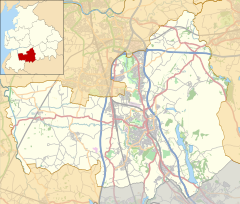Bank Hall Gardens
| Bank Hall Gardens | |
|---|---|
 |
|
| Location in the Borough of Chorley | |
| Type | Private |
| Location | Bretherton, Lancashire |
| Coordinates | 53°40′32″N 2°48′55″W / 53.67552°N 2.8152°WCoordinates: 53°40′32″N 2°48′55″W / 53.67552°N 2.8152°W |
| Area | 18 acres (73,000 m2)+ |
| Opened | Public: 1999 |
| Operated by | Bank Hall Action Group |
| Status | Open for special events |
| Collections | |
| Website | bankhall |
Bank Hall Gardens comprise 18 acres (73,000 m2) of curtilage at Bank Hall, in Bretherton, Lancashire, England. The gardens contain specimen trees including a yew thought to be the oldest in Lancashire. Many architectural features, statues, low garden walls, conservatory and greenhouses have gone but there are plans to recreate them. The Bank Hall Action Group has tended the grounds since its formation in 1995. the group has planted specimen trees and identified the flora and fauna. The group opened the gardens to the public in 1999 after building a security fence, erecting scaffolding to secure the building and clearing the overgrowth. New varieties of snowdrops, some of which are unique to the gardens were uncovered. After a visit from the Snowdrop Society in 2007 the garden has become nationally known for snowdrop carpets during February.
The gardens open for special events through the year.
The gardens were divided by pathways and yew hedges, the smaller gardens included a rose garden, enclosed formal garden, a walled kitchen garden, wildflower garden, arboretum, bog garden and orchards. An arboretum was created by George Anthony Legh Keck who planted specimen trees from around the world. The survivors have been identified and protected. Lady Lilford planted an Atlas Cedar in 1897 to mark Queen Victoria's Diamond Jubilee.
The walled garden contains a greenhouse and potting sheds along the north wall and a heated outdoor wall which runs a quarter of the length of the east wall. The gardeners grew exotic plants and fruit trees in the greenhouses. The apple trees at the south end of the walled garden survived and compromise Laxton's Superb (c.1922), Worcester Pearmain (c.1870), Newton Wonder (c.1890), Bismarck (c.1870), Bramley (c.1809), White Transparent (c.1870), Golden Delicious (c.1914) and Crimson Bramley (c.1913). As of 2013 grafts have been taken off all the fruit trees so that the garden can be restocked with these varieties when the garden is restored. In late 2013 a Mere de Menage (c.1700) tree was found in an old orchard outside the walled garden.
...
Wikipedia

